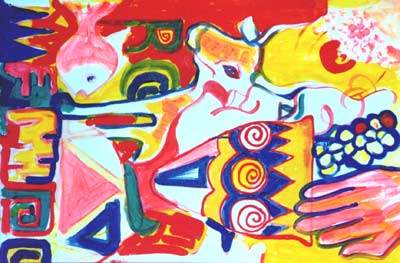BAFA © 2010. All material here is copyrighted. See conditions above. |
Philip Kwesiga
paintings /ceramics, Uganda
|
 
War Child, 1998, oil on canvas,
100 x 210 cm.
|

Lonely Child,
1998,
ceramic vase,
14 cm high.
|
Philip Kwesiga who teaches at the art school at the Makerere University, works in different media, and hails from south western Uganda. He creates images on canvas and pottery portraying families of refugees and family life.
|
excerpts from the article:
War in the eyes of contemporary Ugandan artists
The founder of the Makerere Art School, Margaret Trowell, found that many of the students lived with a sense of strain
and anxiety about their work with no sense of economic or academic security (Bunsen, 1958).
In an attempt to remedy this, the Uganda National Cultural Policy established that artistic and intellectual creation,
which contributes to the development of societies, should be encouraged and strengthened, with attention given to
plastic arts, crafts, design and architecture, and performing arts (1998).
As evidenced in the Platinum Jubilee Art Exhibition at the Makerere Art Gallery in 1997, the pre-independence of
Uganda was a main theme, in the political, magical and religious subject matter. Though most contemporary art in
Uganda can be attributed to the formation of the art school, many of the core elements of Ugandan art were
established by the various religions' missionaries, especially Christian. It is worth noting also that when the art
school was opened, it shared premises with the Uganda Museum, which had been shifted from old Kampala hill to
Makerere hill. The director of the Museum was also the head of the art school.
|

Hunger, 1998, bronze.
|
Paintings such as "The Rocket Furnace" and "The Crush" (plane) by Mubitani (born 1963) illustrate new technologies in
the wrong places. The attempt to depict Ugandan martyrs contained both religious and political paradigms.
"The arrest of Joshua Nkomo" by Aaron Mubtana (1963) had a strong story to tell about peace and independence in Africa.
Before independence, Uganda was divided into small states, which were headed by kings and chiefs in some areas.
The main kingdoms were Buganda, Bunyoro, Ankole, Kooki, Tooro to mention some, and the Acholi, Lugbara, Teso, Langi
and Soga had chiefs as their head too. These various kingdoms were constantly trying to determine who was supreme over
the other. The Chwezi kingdom is believed to have been the largest of its time (1130AD). The most prominent of the wars
was the Bunyoro-Kitara in 1898, the World War II in 1939-45 and recent ones like Kabka crisis in 1966. The 1979 Amin war
and 1981-86 Museveni war.(The war raged for 5 years before the 1986 takeover). All these wars have devastated the economy
of Uganda. During the Museveni era, war has continued in the northern part of Uganda and with instability in the East
(1995) and recently the devastation in Western Uganda especially in Kasese.
With all these periods and occurances a record of works in paintings, sculpture, prints have been created by artists
in Makerere University and around the country. These records are evident in murals made every year by students at
higher institutions.
|

My Wealth, 1999, acrylic on canvas.
|
- Painting: My Wealth, Arts Dialogue, June 2001
- Article: Arts Dialogue, February 2000
- Painting: War Child, Arts Dialogue, December 1999
|

Arts Dialogue, Dintel 20, NL 7333 MC, Apeldoorn, The Netherlands
email: bafa@bahai-library.com
|
|



